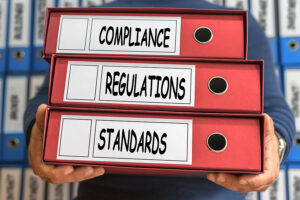
We recently wrote an article about compliance with NFPA 86, a standard from the National Fire Protection Agency for ovens and furnaces. This standard covers pretty much everything having to do with industrial ovens:
- Location and construction
- Heating systems
- Commissioning, operations, maintenance, inspection, and testing (this is what our previous article was about)
- Safety equipment and application
- Fire protection
- And more
This isn’t the only NFPA standard applicable to the baking industry. And the NFPA isn’t the only standards development organization. As you likely know, the American National Standards Institute (ANSI) has two standards for baking equipment:
- ANSI Z50.1 covers safety requirements
- ANSI Z50.2 covers sanitation requirements
NFPA, ANSI, and other standards development organizations aren’t government agencies, and they can’t make or enforce laws. However, the consensus standards they publish are often adopted, in part or in whole, by government agencies, most notably, the Occupational Safety and Health Administration (OSHA). If OSHA adopts one of these standards, it becomes enforceable under the law.
Let’s look at the three ways this can happen.
Incorporation by reference
OSHA can incorporate standards developed by non-governmental organizations “by reference.” This means that OSHA uses an external standard in one of its own standards, which makes the external standard enforceable by law.
For example, NFPA 62-1967 (Standard for Dust Hazards of Sugar and Cocoa) and NFPA 656-1959 (Standard for Dust Hazards in Spice Grinding Plants) are incorporated by reference into OSHA’s Bakery Equipment Standard, 1910.263.
You can find all of the standards OSHA incorporates by reference here.
Citations under other OSHA standards and programs
Even a standard that has not been incorporated by reference can be used to issue citations. One way this happens is that OSHA commonly uses external standards where it doesn’t have a standard of its own.
For example, OSHA does not have a combustible dust standard, but the agency’s Combustible Dust National Emphasis Program (which applies to facilities that process many baking ingredients including flour and sugar) relies on NFPA combustible dust standards to identify hazards.
Similarly, while the Bakery Equipment Standard does not specifically cite NFPA 86, many of the provisions are the same. As an example, under 1910.263(l)(9)(ii), all safety devices on ovens are required to be inspected at least once a year by a representative of the oven manufacturer.
Citations under the General Duty Clause
Finally, OSHA frequently invokes the General Duty Clause. This clause says that employers must provide a place of employment that is “free from recognized hazards that are causing or are likely to cause death or serious physical harm.” It’s a catch-all for any situation where a risk is present, regardless of whether there’s a particular regulation about it.
The take-home message of all of this is that the safest bet is to treat industry consensus standards as if they were legally enforceable because, for all intents and purposes, they are.
If you have any questions about bakery equipment, contact us. Our team of experts is here to help!

